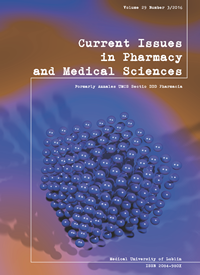Monosaccharide composition of Herniaria glabra L. and Herniaria polygama J.Gay
DOI:
https://doi.org/10.1515/cipms-2016-0030Keywords:
monosaccharides, Herniaria glabra L., Herniaria polygama J.Gay, GS-MSAbstract
The plants from Herniariagenus (Caryophyllaceaefamily) are mainly applied as diuretic agents for the treatment of kidney and gall-stones, gouts, urinary tract infections, hypertension and diabetes. The most widely spread species in Europe is Herniaria glabra L. (HG). Herniaria polygama J.Gay (HP) is found growing from Eastern Europe to Asia. Surprisingly, no work has been reported on the analysis of primary metabolites of HP yet and there is only a limited data on HG. The aim of our study was to establish the monosaccharide composition after a complete hydrolysis and in a free state in the entire herbs of HG and HP harvested in the western and central parts of Ukraine. The carbohydrates were separated by gas chromatography-mass spectrometry after conversion into volatile derivatives as aldononitrile acetate. As a result, the monosaccharide composition after a total hydrolysis was established with the contribution of the following components: D-rhamnose, D-arabinose, D-fucose, D-xylose, D-manose, D-glucose, D-galactose, D-pinitol, myo-inisitol, D-mannitol, D-dulcitol. In a free state it was detected: D-fructose, D-glucose, D-galactose, D-pinitol, myo-inisitol, D-mannitol and D-saccharose. The following monosaccharides were found in the most abundant quantities in HG and HP respectively: glucose was determined as the major component – 33.40 and 22.80 mg/g, the second dominant sugar was pinitol – 16.80 and 18.07 mg/g, followed by galactose – 13.88 mg/g in HG and arabinose – 8.13 mg/g in HP. Sugars were determined in these plant species for the first time and this finding shed new light on their pharmacological application.
References
1. Akulshina E.V. and Darmohray V.N., Results development of techniques chromatospectrometrical definitions of herniarin and umbelliferone in the herb of Herniaria polygama. J. Rossiyskij mediko-biologicheskij vestnik imeni akademika I.P. Pawvlova, 3, 147, 2010.
2. Chen Y. et al, Analysis of the monosaccharide composition of purified polysaccharides in Ganoderma atrum by capillary gas chromatography. J. Phytochem Anal., 20 (60), 503, 2009.
3. Ecoflora of Ukraine. Volume 3. Editor in chief Ya Didukh, 2002, Phytosociocentre, Kiev p.495.
4. Freiler M. et al, New triterpene saponins from Herniaria glabra. J. Helvetica chimica acta, 79, 385, 1996.
5. Garland S. et al, Application of derivatization gas cromatography/mass spectrometry for the identification and quantitation of Pinitol in plant roots. J. Analytical Letters, 42, 2096, 2009.
6. Maleš Ž. et al, Investigation of flavonoids, phenolic acids and amino acids of smooth rupturewort – Herniaria glabra L. J. Farmaceutski glasnik, 69 (11), 2013.
7. Muizelaar J.P. et al, Mannitol causes compensatory cerebral vasoconstriction and vasodilation in response to blood viscosity changes. J. Neurosurg, 59, 822, 1983.
8. Nguyen A. and Lamant A., Pinitol and Myo-inositol accumulation in water-stressed seedlings of seedlings of Maritime pine. J. Phytochemtstry, 27 (11), 3423, 1988.
Downloads
Published
Issue
Section
License
Copyright (c) 2016 Authors

This work is licensed under a Creative Commons Attribution-NonCommercial-NoDerivatives 3.0 Unported License.


